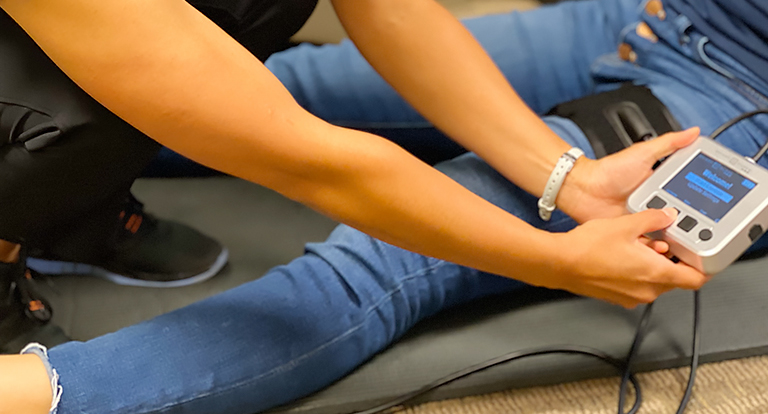Stop that Blood Flow! Blood Flow Restriction Therapy and how it can help you.

History
You may have heard of a recently popular rehab technique called Blood Flow Restriction Training (BFR), and thought it sounded like a strange concept. Simply put, BFR is a technique which blocks blow flow in and out of the arm or leg via a cuff set to a specific pressure (Cognetti 2022). When paired with light exercise, BFR results in muscle growth, and has been utilized both in the fitness space and physical therapy clinics (Cognetti 2022).
This technique was developed in the 1960s incidentally by a gentleman named Yashiaki Sato, a body builder. He initially experimented with blood flow restriction with rubber tubing, and then subsequently used his observations when rehabbing from a leg fracture sustained while skiing a few years later (Sato 2005). Surprisingly, despite being unable to exercise, his doctor found that his recovery was faster than expected, as his muscle mass increased instead of decreased during his rehab (Freitas et al 2021, Sato 2005). His own success provided him further insight into how BFR could be useful for others in his situation, and he spent the next several years performing extensive trial and error to develop the KAATSU technique for safe public use, which was available by 1983 (Sato 2005).
How does BFR work?
It seems counterintuitive that cutting off blood supply to a limb would have benefits! BFR essentially blocks a portion of the normal blood flow into and out of a limb, it creates a low oxygen, low blood flow environment for the muscle. This environment then increases both metabolic and mechanical stress to the muscle, resulting in the accumulation of metabolites, molecules which influence muscle growth at the cellular level (Hughes et al 2007, Cognetti et al 2022), as well as activates fast twitch muscle fibers, which simulates the same effect that occur with higher intensity exercise (Hughes et al 2007). Additionally, cellular swelling can also increase protein synthesis, which are the building blocks of muscle (Hughes et al 2007, Cognetti et al 2022). BFR’s effects at the cellular level essentially trick the muscle into behaving as if they experienced a heavy workout, when in fact, the exercise intensity was light. This has several applications when recovering from an injury.
Applications
- Post Surgical: BFR works well alongside low intensity exercise to encourage muscle growth. Because of this, surgical patients who require recovery time with reduced weight bearing or have strict post-operative precautions requiring rest can still work on muscle growth while simultaneously reducing muscle atrophy. BFR has been studied extensively in patient’s post-op ACL reconstruction, and is beneficial for regaining quadriceps muscle volume often lost during and after surgery (Hughes et al 2007, Cognetti et al 2022).
- Older Populations: Another population on which BFR is beneficial is older adults, who frequently suffer from loss of strength and walking ability due to sedentary lifestyles or other injuries (Cognetti et al 2022). Since these older adult populations may be unable to tolerate intense strengthening routines due to excessive joint stress, light intensity exercise is recommended (Hughes et al 2007). With the addition of BFR, they can perform lower intensity exercise coupled with BFR to reduce any additional stress on their joints, and still achieve the strength building aspect of higher intensity exercise.
- Joint Pain and Arthritis: Individuals with chronic inflammatory issues and pain (such as arthritis, chronic fatigue, and fibromyalgia) may benefit similarly to older adult populations due to reduced exercise tolerance levels (Freitas et al 2021).
- Power and Endurance Athletes: BFR has been studied in various athletic populations, and may be beneficial for improving muscle strength, muscle size, and markers of sports performance (Wortman et al 2020), Davids et al 2023). Several studies’ results indicate that endurance athletes may benefit more than sprint athletes, as these endurance athletes exhibited improvements in VO2 max, or the efficiency of the muscles to use oxygen delivered (Pignanelli et al 2021; Takada et al 2012). Most studies indicate that BFR may be a beneficial supplement to resistance training, performed either in the pre-season or post-workout (Wortman et al 2020; Davids et al 2023; Pignanelli et al 2021).
Are there any risks or side effects?
As with any rehab tool, there are risks involved, and your PT will screen you appropriately for these items to ensure your safe participation. Once screened, the evidence suggests that BFR does not worsen a patient’s condition or exercise-related pain, and there is low risk for muscle issues arising post-treatment (Hughes et al 2007, Freitas et al 2021).
There are several common, but normal, side effects that may arise post-BFR, including delayed onset muscle soreness, bruising, and temporary numbness (Cognetti et al 2022). While your PT will educate you on these side effects, it’s important for you to be aware of these, not only to reduce your concern with participating in this treatment method, but also to understand both normal and abnormal responses.
Summary
Overall, BFR is a great way to address muscle loss in patients recovering from surgery, deconditioning due to sedentary lifestyle, and some chronic inflammatory conditions. Recent research indicates that athletes may benefit from the addition of BFR to their resistance training routines. The blood flow occlusion that occurs creates a cellular environment like that created with high intensity exercise, and can result in similar muscle volume, strength, power, and endurance gains. While there are some minor side affects you may experience, your PT has been trained to both screen and monitor you throughout treatment. BFR can be an excellent addition to many treatment programs and is worth discussing with your PT to see if you are a viable candidate!
References:
- Cognetti DJ, Shean AJ, Owens JG. Blood Flow Restriction Therapy and Its Use for Rehabilitation and Return to Sport: Physiology, Application, and Guidelines for Implementation. Arthosc Sports Med Rehabil. 2022 Jan; 4(1): e71–e76. https://www.ncbi.nlm.nih.gov/pmc/articles/PMC8811521/
- Sato Y. The history and future of Kaatsu training. Int. J. Kaatsu Training Res. 2005; 1:1-5. https://www.jstage.jst.go.jp/article/ijktr/1/1/1_1_1/_pdf/-char/en
- Hughes L, Paton B, Rosenblatt B, et al. Blood flow restriction training in clinical musculoskeletal rehabilitation: a systematic review and meta-analysis. British Journal of Sports Medicine 2017;51:1003-1011. https://bjsm.bmj.com/content/51/13/1003
- Freitas EDS, Karabulut M, Bemben M. The Evolution of Blood Flow Restricted Exercise. Fron in Phys. 2021;12:1-12. https://www.frontiersin.org/articles/10.3389/fphys.2021.747759/full
- Takada S, Okita K, Suga T, et al. Blood Flow Restriction Exercise in Sprinters and Endurance Runners. Amer Coll of Sports Med. 2012; 413-419.
- Pignanelli C, Christiansen D, Burr J. Bloodflow restriction training and the high-performance athlete: science to application. J Appl Physiol 2021; 130: 1163–1170. doi:10.1152/japplphysiol.00982.2020
- Wortman RJ, Brown SM, Savage-Elliott I, Finley ZJ, Mulcahey M. Bloodflow restriction for athletes: A systematic review. Amer J Sp Med. 2020. doi:10.1177/03653546520964454
- Davids CJ, Roberts LA, Bjorsen T, et al. Where does bloodflow restriction fit in the toolbox of athletic development? A narrative review of the proposed mechanisms and potential applications. Sports Medicine 2023. https://doi.org/10.1007/s40279-023-01900-6

